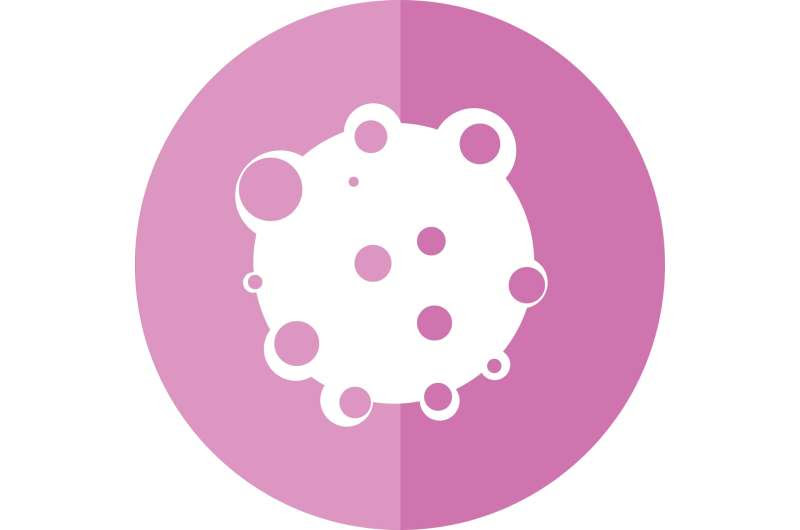by Mass General Brigham

Credit: Pixabay/CC0 Public Domain
Intratumoral therapy—in which cancer drugs are injected directly into tumors—is a promising treatment option for solid cancers but has shown limited success in clinical trials due to an inability to precisely deliver the drug and because most immunotherapies quickly dissipate from the site of injection.
A team of researchers from Mass General Brigham, in collaboration with colleagues at the Koch Institute for Integrative Cancer Research, has developed a gel delivery system that overcomes these challenges. The gel is injectable but solidifies upon delivery; contains an imaging agent for visualization under CT scan; and can hold a high concentration of drug for slow, controlled release.
In a paper published in Advanced Healthcare Materials, the team reports that using gel-delivered imiquimod (an immune stimulating drug) in combination with checkpoint inhibitor therapy induced tumor regression and increased survival in mouse models of colon and breast cancer that are usually resistant to checkpoint inhibitor therapy. The treatment also appeared to train the immune system to detect and attack distant tumors that were not directly treated, suggesting that it might be a helpful therapy for metastatic cancers.
“This gel tackles the two problems with existing attempts at making intratumoral cancer immunotherapy: making the therapy visible and practical so that interventional radiologists can confirm delivery, and making sure the drug actually stays in the region of interest,” said Avik Som, MD, Ph.D., of the Department of Radiology at Massachusetts General Hospital.
“When we inject this gel into a tumor, we’re able to teach the immune system to recognize the cancer and trigger it to attack not only the site where the gel was injected, but also other areas in the body where the same cancer may be hiding.”
The research team, which consisted of both engineers and medical professionals, first developed and optimized the gel-delivery system in the lab by tweaking the gel’s chemical structure. One key aspect of the gel’s design was that it needed to shift from being liquid at room temperature to make it injectable but become solid at body temperature inside the tumor in order to form a drug-releasing depot, while also retaining drug encapsulation and delivery capability, and carrying sufficient imaging agent.
After optimizing the gel in the lab, the team tested its ability to treat mouse models of colon and breast cancer that are usually resistant to immunotherapy. To do this, they used the gel to deliver imiquimod, an FDA-approved immune stimulating drug, in combination with checkpoint inhibitor therapy. Each mouse had two tumors of the same type, but the researchers only treated one tumor per mouse, which allowed them to test the gel’s ability to stimulate both local and systemic immunity.
They showed that treating with gel-delivered imiquimod in combination with checkpoint inhibitor therapy improved survival in both cancer models. The treatment resulted in an all-or-nothing response—mice that responded to the treatment showed complete regression of both the treated tumor and a distantly located tumor (a model for metastasis), while non-responders showed no regression at either site. For the colon cancer model, 46% (6/13) survived when the checkpoint inhibitor therapy was combined with gel-delivered imiquimod. For the breast cancer model, 20% (3/15) survived when treated with the combined therapies.
“These two tumors remain challenging to treat today, even though immunotherapies are transforming how we think about treatment,” said co-corresponding author Giovanni Traverso, MB, Ph.D., MBBCH, Department of Medicine at Brigham and Women’s Hospital and an associate professor in the Department of Mechanical Engineering at MIT. “The fact that we were able to induce responses in distant tumors in these colon and breast cancer models was a big win.”
The researchers are keen to move this technology to the clinic, but it will first need to go through more rounds of testing for safety. They also plan to test its efficacy with a broader panel of drugs.
“This is an early proof of concept, but we’re all actively working together to try and get these technologies to patients,” said Eric Wehrenberg-Klee, MD, assistant radiologist in the Department of Radiology at Massachusetts General Hospital and one of the study’s first authors. “There’s quite a bit of benefit to be gained by being able to treat patients with a single injection, and we think this technology has the potential to help with cancers that are currently challenging to treat.”
Authors include Jan-Georg Rosenboom (MGH, BWH, MIT), Alana Chandler (MIT), Gabrielle Ndakwah (BWH, MIT), Eric Chen (MIT), Jack Suggs (MIT), Joshua Morimoto (MIT), Jonathan Kim (MGH), Abdul Rehman Mustafa (MGH), Asier Marcos-Vidal (MGH), Florian J. Fintelmann (MGH), Arijit Basu (MIT), Robert Langer (MIT), and Umar Mahmood (MGH).
More information: Avik Som et al, Percutaneous Intratumoral Immunoadjuvant Gel Increases The Abscopal Effect of Cryoablation for Checkpoint Inhibitor Resistant Cancer, Advanced Healthcare Materials (2023). DOI: 10.1002/adhm.202301848
Journal information: Advanced Healthcare Materials

Leave a Reply